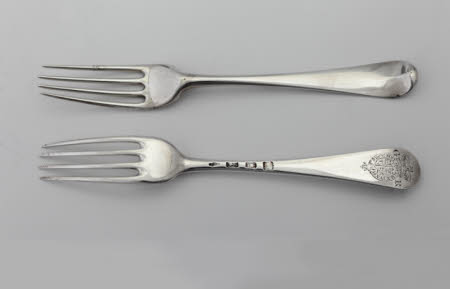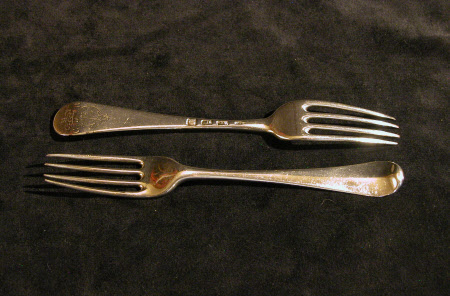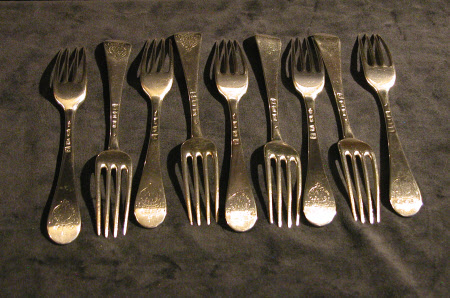Table fork
Paul Callard
Category
Silver
Date
1758 - 1759
Materials
Sterling silver
Measurements
2.4 cm (Width); 19 cm (Length)
Place of origin
London
Order this imageCollection
Ickworth, Suffolk
NT 852099.41
Summary
Table fork, sterling silver, by Paul Callard, London, 1758/9. One of nine. The fork is forged from a single piece of silver and is of the Hanoverian pattern with four tines. The stems are plain and tapered and the upturned terminals are engraved on the reverse with the quartered arms of the Hanoverian monarchs (pre-1801) within the Garter and beneath an imperial crown flanked by the initials GR.
Full description
Three dozen table forks, spoons (see NT 852099.2-18) and knives (see NT 852203.5-10) came to George Hervey, 2nd Earl of Bristol (1721-75) in 1758 as part of his official allocation of plate on going to Spain as ambassador. He would have needed such a large overall number as the English custom was to change them each time a plate was removed,[1] and he had ten dozen plates. For his cutlery and flatware the Earl did not expend any more than he needed to on fashion, sticking to the simplest of forms. With his shrewd assessment of where display would count he must have decided that the diner’s eye would not be sufficiently resting on the implements they were using and would be drawn more by the dishes and tureens containing the fine food they were feasting upon. It was, anyway, very unusual for more decoration to be applied to knives and flatware at this time in England, an exception being the early 1740s table service of the 4th Earl of Chesterfield, made partly in Paris and partly by Paul Crespin in London.[2] Lord Bristol is likely to have acquired others of this pattern of fork before and after these were commissioned, as he did spoons (see NT 852000.1 & 19-29). By 1811 there were forty-eight each of this pattern of knife and fork remaining, and thirty-six spoons. They had diminished to twenty-four, nine and twenty-seven by 1951.[3] All the surviving forks and spoons and six of the knives came to the National Trust in 1956. James Rothwell, Decorative Arts Curator January 2021 [Adapted from James Rothwell, Silver for Entertaining: The Ickworth Collection, London 2017, cat. 69, pp. 152-3.] Notes: [1] Madame van Muyden (ed.), A Foreign View of England in the Reigns of George I & George II: The Letters of Monsieur César de Saussure to his Family, 1902, p. 222. [2] Christopher Hartop, The Huguenot Legacy: English Silver 1680-1760, 1996, p. 101, ill. [3] Suffolk Record Office, HA 507/9/21, List of silver etc offered in lieu of death duties, c.1951, pp. 6 & 16.
Provenance
Jewel Office; allocated to George Hervey, 2nd Earl of Bristol (1721-75) as Ambassador to Madrid 1758; discharged to Lord Bristol 9th April, 1759; by descent to the 4th Marquess of Bristol (1863-1951); accepted by the Treasury in lieu of death duties in 1956 and transferred to the National Trust.
Credit line
Ickworth, the Bristol Collection (National Trust)
Marks and inscriptions
Stem: Hallmarks: maker’s mark ‘PC’ beneath two mullets and above a fleur-de-lis (Arthur Grimwade, London Goldsmiths 1697-1837, 1990, no. 2150), lion passant, leopard’s head and date letter ‘C’.
Makers and roles
Paul Callard, goldsmith


